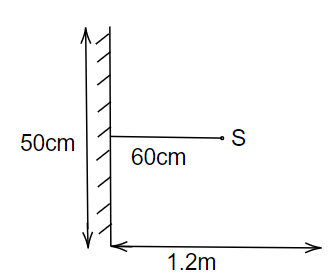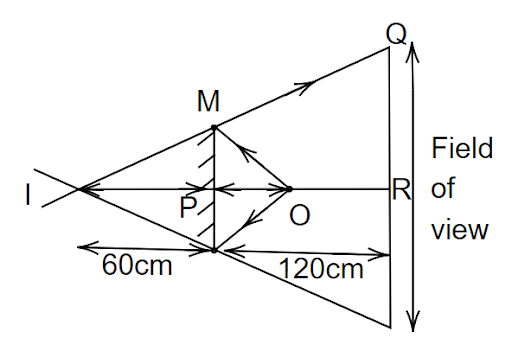
A point source of light S, placed at a distance of 60 cm in front of the center of the plane mirror of width 50 cm, hangs vertically on a wall. A man walks in front of the mirror along a line parallel to the mirror at a distance of 1.2 m from it (see in the figure). Find the distance between the extreme points where he can see the image of the light source in the mirror.

Answer
216.3k+ views
Hint: The mirrors are polished surfaces, which are coated on one side with Mercury so that they can reflect most of the light that falls on them. A plane mirror always forms a virtual image and the virtual image is produced when the light rays from a source don’t cross or meet at a point to form an image.
Complete step by step solution:

Image: A mirror placed at a distance of 60 cm from the source.
Consider a line parallel to the mirror, where a man is moving on it and a light source is placed at a distance of 60 cm and the length of the mirror is 50 cm. we need to find the distance between the extreme points where he can see the image of the light source in the mirror. From the figure, consider the triangle IMP and IQR which are similar to each other. Therefore, we can write as,
\[\dfrac{{QR}}{{MP}} = \dfrac{{IR}}{{IP}}\]
\[\Rightarrow \dfrac{{QR}}{{25}} = \dfrac{{180}}{{60}}\]
\[\Rightarrow QR = 75\,cm\]
Then in order to obtain the field of view that is, the distance between the extreme points where he can see the image of the light source in the mirror is,
The field of view \[ = 2 \times QR\]
The field of view \[ = 2 \times 75\]
The field of view \[ = 150\,cm\]
Therefore, the distance between the extreme points where he can see the image of the light source in the mirror is 150 cm.
Note:Suppose when a light ray falls on a surface, it can undergo one of the three phenomena, namely, reflection, refraction, and absorption. Most of the light gets absorbed when a ray of light falls on a normal surface. Based on the reflecting surface, we can classify mirrors as convex mirrors, concave mirrors, or plane mirrors.
Complete step by step solution:

Image: A mirror placed at a distance of 60 cm from the source.
Consider a line parallel to the mirror, where a man is moving on it and a light source is placed at a distance of 60 cm and the length of the mirror is 50 cm. we need to find the distance between the extreme points where he can see the image of the light source in the mirror. From the figure, consider the triangle IMP and IQR which are similar to each other. Therefore, we can write as,
\[\dfrac{{QR}}{{MP}} = \dfrac{{IR}}{{IP}}\]
\[\Rightarrow \dfrac{{QR}}{{25}} = \dfrac{{180}}{{60}}\]
\[\Rightarrow QR = 75\,cm\]
Then in order to obtain the field of view that is, the distance between the extreme points where he can see the image of the light source in the mirror is,
The field of view \[ = 2 \times QR\]
The field of view \[ = 2 \times 75\]
The field of view \[ = 150\,cm\]
Therefore, the distance between the extreme points where he can see the image of the light source in the mirror is 150 cm.
Note:Suppose when a light ray falls on a surface, it can undergo one of the three phenomena, namely, reflection, refraction, and absorption. Most of the light gets absorbed when a ray of light falls on a normal surface. Based on the reflecting surface, we can classify mirrors as convex mirrors, concave mirrors, or plane mirrors.
Recently Updated Pages
Wheatstone Bridge Explained: Working, Formula & Uses

Young’s Double Slit Experiment Derivation Explained

JEE Atomic Structure and Chemical Bonding important Concepts and Tips

JEE Amino Acids and Peptides Important Concepts and Tips for Exam Preparation

Electricity and Magnetism Explained: Key Concepts & Applications

Chemical Properties of Hydrogen - Important Concepts for JEE Exam Preparation

Trending doubts
JEE Main 2026: Application Form Open, Exam Dates, Syllabus, Eligibility & Question Papers

Derivation of Equation of Trajectory Explained for Students

Hybridisation in Chemistry – Concept, Types & Applications

Understanding the Angle of Deviation in a Prism

Understanding Collisions: Types and Examples for Students

How to Convert a Galvanometer into an Ammeter or Voltmeter

Other Pages
JEE Advanced Marks vs Ranks 2025: Understanding Category-wise Qualifying Marks and Previous Year Cut-offs

Ideal and Non-Ideal Solutions Explained for Class 12 Chemistry

Degree of Dissociation: Meaning, Formula, Calculation & Uses

Understanding Electromagnetic Waves and Their Importance

Understanding the Electric Field of a Uniformly Charged Ring

Understanding Average and RMS Value in Electrical Circuits




